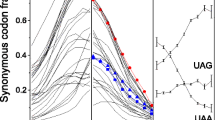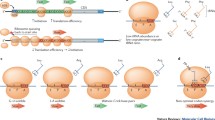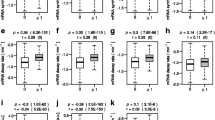Abstract
The usage of synonymous codons (SCs) in mammalian genes is highly correlated with local base composition and is therefore thought to be determined by mutation pressure. The usage is nonetheless structured. For instance, mammals share with Saccharomyces and Drosophila most preferences for the C-ending over the G-ending codon (or vice versa) within each fourfold-degenerate SC family and the fact that their SCs are placed along coding regions in ways that minimize the number of T|A and C|G dinucleotides (“|” being the codon boundary). TA and CG underrepresentations are observed everywhere in the mammalian genome affecting the SC usage, the amino acid composition of proteins, and the primary structure of introns and noncoding DNA. While the rarity of CG is ascribed to the high mutability of this dinucleotide, the rarity of TA in coding regions is considered adaptive because UA dinucleotides are cleaved by endoribonucleases. Here we present in vivo experimental evidence indicating that the number of T|A and/or C|G dinucleotides of a human gene can affect strongly the expression level and degradation of its mRNA. Our results are consistent with indirect evidence produced by other workers and with the detailed work that has been devoted to characterize UA cleavage in vitro and in vivo. We conclude that SC choice can influence strongly mRNA function and gene expression through effects not directly related to the codon–anticodon interaction. These effects should constrain heavily the nucleotide motif composition of the most abundant mRNAs in the transcriptome, in particular, their SC usage, a usage that must be reflected by cellular tRNA concentrations and thus defines for all other genes which SCs are translated fastest and most accurately. Furthermore, the need to avoid such effects genome-wide appears serious enough to have favored the evolution of biases in context-dependent mutation that reduce the occurrence of intrinsically unfavorable motifs, and/or, when possible, to have induced the molecular machinery mediating such effects to rely opportunistically on already existing motif rarities and abundances. This may explain why nucleotide motif preferences are very similar in transcribed and nontranscribed mammalian DNA even though the preferences appear to be adaptive only in transcribed DNA.


Similar content being viewed by others
References
MA Antezana M Kreitman (1999) ArticleTitleThe nonrandom location of synonymous codons suggests that reading frame-independent forces have patterned codon preferences. J Mol Evol 49 IssueID1 36–43 Occurrence Handle1:CAS:528:DyaK1MXkt1Oktr8%3D Occurrence Handle10368432
Antezana MA, Kreitman M. Unpublished data
JL Bennetzen BD Hall (1982) ArticleTitleCodon selection in yeast. J Biol Chem 257 3026–3031 Occurrence Handle1:CAS:528:DyaL38XitFWkt7w%3D Occurrence Handle7037777
OG Berg PJ Silva (1997) ArticleTitleCodon bias in Escherichia coli: The influence of codon context on mutation and selection. Nucleic Acids Res 25 IssueID7 1397–1404 Occurrence Handle10.1093/nar/25.7.1397 Occurrence Handle1:CAS:528:DyaK2sXis1Skt7g%3D Occurrence Handle9060435
E Beutler T Gelbart JH Han JA Koziol B Beutler (1989) ArticleTitleEvolution of the genome and the genetic code: Selection at the dinucleotide level by methylation and polyribonucleotide cleavage. Proc Natl Acad Sci USA 86 IssueID1 192–196 Occurrence Handle1:CAS:528:DyaL1MXht12lsb8%3D Occurrence Handle2463621
G Candelas T Candelas A Ortiz O Rodriguez (1983) ArticleTitleTranslational pauses during a spider fibroin synthesis. Biochem Biophys Res Commun 116 IssueID3 1033–1038 Occurrence Handle1:CAS:528:DyaL2cXitVOgsQ%3D%3D Occurrence Handle6651838
G Caponigro R Parker (1996) ArticleTitleMechanisms and control of mRNA turnover in Saccharomyces cerevisiae. Microbiol Rev 60 IssueID1 233–249 Occurrence Handle1:CAS:528:DyaK28XitVyrsLg%3D Occurrence Handle8852902
G Chavancy JP Garel (1981) ArticleTitleDoes quantitative tRNA adaptation to codon content in mRNA optimize the ribosomal translation efficiency? Proposal for a translation system model. Biochimie 63 IssueID3 187–195 Occurrence Handle1:CAS:528:DyaL3MXhsFajsLk%3D Occurrence Handle7225463
A Deana R Ehrlich C Reiss (1996) ArticleTitleSynonymous codon selection controls in vivo turnover and amount of mRNA in Escherichia coli bla and ompA genes. J Bacteriol 178 IssueID9 2718–2720 Occurrence Handle1:CAS:528:DyaK28Xislygtr0%3D Occurrence Handle8626345
L Duret N Galtier (2000) ArticleTitleThe covariation between TpA deficiency, CpG deficiency, and G+C content of human isochores is due to a mathematical artifact. Mol Biol Evol 17 IssueID11 1620–1625 Occurrence Handle1:CAS:528:DC%2BD3cXnvFyqtrw%3D Occurrence Handle11070050
DC Eichler SJ Eales (1983) ArticleTitleThe effect of RNA secondary structure on the action of a nucleolar endoribonuclease. J Biol Chem 258 IssueID16 10049–10053 Occurrence Handle1:CAS:528:DyaL3sXltFygtbc%3D Occurrence Handle6193106
DC Eichler TF Tatar (1980) ArticleTitleProperties of a purified nucleolar ribonuclease from Ehrlich ascites carcinoma cells. Biochemistry 19 IssueID13 3016–3022 Occurrence Handle1:CAS:528:DyaL3cXks1Cgsbk%3D Occurrence Handle7397114
W Fiers R Contreras G Haegeman R Rogiers A Van de Voorde H Van Heuverswyn J Van Herreweghe G Volckaert M Ysebaert (1978) ArticleTitleComplete nucleotide-sequence of SV40 DNA. Nature 273 113–120 Occurrence Handle1:CAS:528:DyaE1cXlsVajs7Y%3D Occurrence Handle205802
R Grantham C Gautier M Gouy M Jacobzone R Mercier (1981) ArticleTitleCodon catalog usage is a genome strategy modulated for gene expressivity. Nucleic Acids Res 9 IssueID1 R43–R74 Occurrence Handle7208352
H Grosjean W Freirs (1982) ArticleTitlePreferential codon usage in prokaryotic genes: The optimal codon-anti-codon interaction energy and the selective codon usage in efficiently expressed genes. Gene 18 199–209 Occurrence Handle10.1016/0378-1119(82)90157-3 Occurrence Handle1:CAS:528:DyaL38XmtV2ntr0%3D Occurrence Handle6751939
A Hoekema RA Kastelein M Vasser HA de Boer (1987) ArticleTitleCodon replacement in the PGK1 gene of Saccharomyces cerevisiae: Experimental approach to study the role of biased codon usage in gene expression. Mol Cell Biol 7 IssueID8 2914–2924 Occurrence Handle1:CAS:528:DyaL2sXlt1yhu7s%3D Occurrence Handle2823108
J Josse AD Kaiser A Kornberg (1961) ArticleTitleEnzymatic synthesis of deoxyribonucleic acid. 8. Frequencies of nearest neighbor base sequences in deoxyribonucleic acid. J Biol Chem 236 IssueID3 864–875 Occurrence Handle1:CAS:528:DyaF3MXns1CltA%3D%3D Occurrence Handle13790780
FC Kafatos A Efstratiadis BG Forget SM Weissman (1977) ArticleTitleMolecular evolution of human and rabbit beta-globin mRNAs. Molecular evolution of human and rabbit beta-globin messenger-RNAs. Proc Natl Acad Sci USA 74 IssueID12 5618–5622 Occurrence Handle1:CAS:528:DyaE1cXosVOgsw%3D%3D Occurrence Handle271989
S Karlin C Burge (1995) ArticleTitleDinucleotide relative abundance extremes: A genomic signature. Trends Genet 11 IssueID7 283–290 Occurrence Handle1:CAS:528:DyaK2MXmvVahtLY%3D Occurrence Handle7482779
O Konu MD Li (2002) ArticleTitleCorrelations between mRNA expression levels and GC contents of coding and untranslated regions of genes in rodents. J Mol Evol 54 IssueID1 35–41 Occurrence Handle1:CAS:528:DC%2BD3MXovFKgu7c%3D Occurrence Handle11734896
I Lemm J Ross (2002) ArticleTitleRegulation of c-myc mRNA decay by translational pausing in a coding region instability determinant. Mol Cell Biol 22 IssueID12 3959–3969 Occurrence Handle10.1128/MCB.22.12.3959-3969.2002 Occurrence Handle1:CAS:528:DC%2BD38XktlSmtb8%3D Occurrence Handle12024010
GG Lennon NW Fraser (1983) ArticleTitleCpG frequency in large DNA segments. J Mol Evol 19 IssueID3–4 286–288 Occurrence Handle1:CAS:528:DyaL3sXltFOjtbk%3D Occurrence Handle6577204
F Lustig T Boren C Claesson C Simonsson M Barcisszewska U Lagerkvist (1993) ArticleTitleThe nucleotide in position 33 of the tRNA anticodon loop determines ability of anticodon UCC to discriminate among glycine codons. Proc Natl Acad Sci USA 90 3343–3347 Occurrence Handle1:CAS:528:DyaK3sXisV2qsL8%3D Occurrence Handle8475078
R Nussinov (1981a) ArticleTitleEukaryotic dinucleotide preference rules and their implications for degenerate codon usage. J Mol Biol 149 IssueID1 125–131 Occurrence Handle1:CAS:528:DyaL3MXlsVGntL0%3D
R Nussinov (1981b) ArticleTitleNearest neighbor nucleotide patterns. Structural and biological implications. J Biol Chem 256 IssueID16 8458–8462 Occurrence Handle1:CAS:528:DyaL3MXlt1Olu70%3D
M Oprea LG Cowell TB Kepler (2001) ArticleTitleThe targeting of somatic hypermutation closely resembles that of meiotic mutation. J Immunol 166 IssueID2 892–899 Occurrence Handle1:CAS:528:DC%2BD3MXlvVWisg%3D%3D Occurrence Handle11145665
J Parker (1989) ArticleTitleErrors and alternatives in reading the universal genetic code. Microbiol Rev 53 IssueID3 273–298 Occurrence Handle1:CAS:528:DyaL1MXlvVygtLk%3D Occurrence Handle2677635
R Parker A Jacobson (1990) ArticleTitleTranslation and a 42-nucleotide segment within the coding region of the mRNA encoded by the MAT alpha 1 gene are involved in promoting rapid mRNA decay in yeast. Proc Natl Acad Sci USA 87 IssueID7 2780–2784 Occurrence Handle1:CAS:528:DyaK3cXitFWrsLc%3D Occurrence Handle2181450
FJ Perlak RL Fuchs DA Dean SL McPherson DA Fischhoff (1991) ArticleTitleModification of the coding sequence enhances plant expression of insect control protein genes. Proc Natl Acad Sci USA 88 IssueID8 3324–3328 Occurrence Handle1:CAS:528:DyaK3MXktVaguro%3D Occurrence Handle2014252
LE Post M Nomura (1979) ArticleTitleNucleotide sequence of the intercistronic region preceding the gene for RNA polymerase subunit alpha in Escherichia coli. Biol Chem 254 IssueID21 10604–10606 Occurrence Handle1:CAS:528:DyaL3cXhslektg%3D%3D
LE Post GD Strycharz M Nomura H Lewis PP Dennis (1979) ArticleTitleNucleotide sequence of the ribosomal protein gene cluster adjacent to the gene for RNA polymerase subunit beta in Escherichia coli. Proc Natl Acad Sci USA 76 IssueID4 1697–1701 Occurrence Handle1:CAS:528:DyaE1MXksFWhurg%3D Occurrence Handle377281
J Precup J Parker (1987) ArticleTitleMissense misreading of asparagine codons as a function of codon identity and context. Biol Chem 262 IssueID23 11351–11355 Occurrence Handle1:CAS:528:DyaL2sXlt1yitLY%3D
L Qiu A Moreira G Kaplan R Levitz JY Wang C Xu K Drlica (1998) ArticleTitleDegradation of hammerhead ribozymes by human ribonucleases. Mol Gen Genet 258 IssueID4 352–362 Occurrence Handle10.1007/s004380050741 Occurrence Handle1:CAS:528:DyaK1cXjvF2hsrc%3D Occurrence Handle9648739
GJ Russell JH Subak-Sharpe (1967) ArticleTitleSimilarity of the general designs of protochordates and invertebrates. Nature 266 533–536
W Salser (1978) ArticleTitleGlobin mRNA sequences: Analysis of base pairing and evolutionary implications. Cold Spring Harbor Symp Quant Biol 42 IssueID2 985–1002 Occurrence Handle1:CAS:528:DyaE1cXlsFyqtrw%3D Occurrence Handle277330
W Seffens D Digby (1999) ArticleTitlemRNAs have greater negative folding free energies than shuffled or codon choice randomized sequences. Nucleic Acids Res 27 IssueID7 1578–1584 Occurrence Handle10.1093/nar/27.7.1578 Occurrence Handle1:CAS:528:DyaK1MXisVCjsbY%3D Occurrence Handle10075987
P Setlow (1976) . GD Fasman (Eds) Handbook of biochemistry and molecular biology. CRC Press Cleveland, OH 312–318
DS Smith G Creadon PK Jena JP Portanova BL Kotzin LJ Wysocki (1996) ArticleTitleDi- and trinucleotide target preferences of somatic mutagenesis in normal and autoreactive B cells. J Immunol 156 IssueID7 2642–2652 Occurrence Handle1:CAS:528:DyaK28XhvVGltb0%3D Occurrence Handle8786330
AO Urrutia LD Hurst (2001) ArticleTitleCodon usage bias covaries with expression breadth and the rate of synonymous evolution in humans, but this is not evidence for selection. Genetics 59 IssueID3 1191–1199
JR Williamson (1994) ArticleTitleG-quartet structures in telomeric DNA. Annu Rev Biophys Biomol Struct 23 703–730 Occurrence Handle10.1146/annurev.bb.23.060194.003415 Occurrence Handle1:CAS:528:DyaK2MXitVaqtg%3D%3D Occurrence Handle7919797
C Workman A Krogh (1999) ArticleTitleNo evidence that mRNAs have lower folding free energies than random sequences with the same dinucleotide distribution. Nucleic Acids Res. 27 4816–4822 Occurrence Handle10.1093/nar/27.24.4816 Occurrence Handle1:CAS:528:DC%2BD3cXlsVOh Occurrence Handle10572183
M Zama (1997) ArticleTitleTranslational pauses during the synthesis of proteins and mRNA structure. Nucleic Acids Symp Ser 37 179–180 Occurrence Handle1:CAS:528:DyaK1cXivFCnt7s%3D Occurrence Handle9586058
J Zhou WJ Liu SW Peng XY Sun I Frazer (1999) ArticleTitlePapillomavirus capsid protein expression level depends on the match between codon usage and tRNA availability. J Virol 73 4972–4982 Occurrence Handle1:CAS:528:DyaK1MXjtFerur0%3D Occurrence Handle10233959
S Zolotukhin M Potter WW Hauswirth J Guy N Muzyczka (1996) ArticleTitleA “humanized” green fluorescent protein cDNA adapted for high-level expression in mammalian cells. J Virol 70 4646–4654 Occurrence Handle1:CAS:528:DyaK28XjsFygsb0%3D Occurrence Handle8676491
Acknowledgements
We thank Elliott Gershon, Marry Kreitman, Carlos C Machado, Ira Wool, Matthew Meselson, and an anonymous reviewer for comments, advice, literature indications, and/or encouragement; and Janice Spofford, Martha Hamblin, Esther Betran, Lisa Noble, Donovan Conrad, Antonio Grinbergo, Charles Langley, Wolfgang Stephan, Peter Stadler, Mactias Gerberding, and Shin-Han Hui for comments and/or editorial advice. The synthetic sequences were financed by a grant from The University of Chicago’s Brain Research Foundation to M.A. Antezana and Pablo Gejman. J. Duan was supported by a NARSAD Young Investigator Award. We warmly thank P. Gejman for his enthusiastic belief in the project, for the use of his laboratory and supplies, and for salary support.
Author information
Authors and Affiliations
Corresponding author
Rights and permissions
About this article
Cite this article
Duan, J., Antezana, M.A. Mammalian Mutation Pressure, Synonymous Codon Choice, and mRNA Degradation . J Mol Evol 57, 694–701 (2003). https://doi.org/10.1007/s00239-003-2519-1
Received:
Accepted:
Issue Date:
DOI: https://doi.org/10.1007/s00239-003-2519-1




